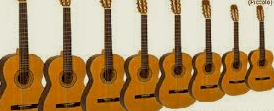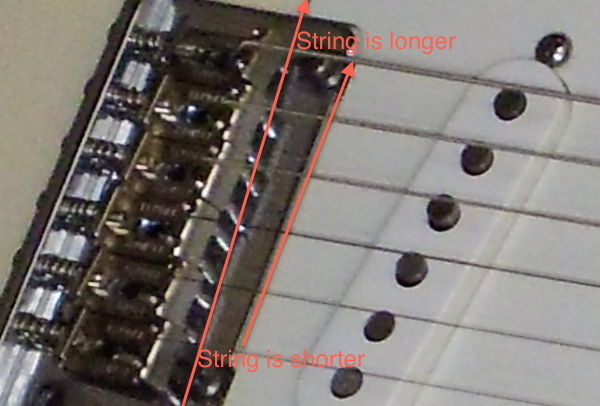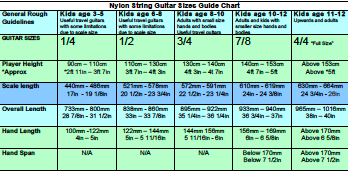What Guitar Sizes Are There?
The idea of guitar sizes can be confusing. Lets face it in one way they all look alike, but in another way when we look more closely the shapes seem unique and infinite in variety. The shortest answer is that guitar sizes are usually quoted in fractions. From 1/4 size, 1/2 size, 3/4 size, (occasionally 3/8 size), 7/8 size and finally 4/4 or "full size" guitars. The trick is understanding what that means.
It’s like spilling a small amount of ink on a page. We glance; we see a splotch of ink. One splotch of ink is like any other splotch of ink, until we are asked to describe it or measure it. Then it becomes a challenging conundrum.
It is important to keep in mind the object and end goal of all this size and measurement stuff. Simply put we want to match the size of an instrument to fit the size of a person with the correct types of guitar for the style of music to be played.
(What about guitar sizes for small hands?)


So the real answer as to "what guitar sizes are there?" is that imagination, creativity, time and money are the only boundaries. So where does that leave us? Well you can read on and get the fuller picture or if you are a "just do it" person go straight to the
PDF Guide Charts
...and head for the music shop. (N.B.Corrections: the two last boxes on the bottom right side of all charts should read 6 and1/2 and not 7 and1/2 inches. I will replace the charts as soon as I can)
...If you find any of the information presented here useful please help support this site. It doesn't have to cost you money or time to do so
...many thanks :-)

How Do We Measure Guitar Sizes?

Well the simple annoying answer to that question would be “with a measuring tape!” …but I want you to come back another day…
...so the sensible answer aside from a measuring tape is that you have to know what to measure to get any joy.
There are really three main things we need to measure.
- The scale length
- The "outside" dimensions
- The guitar players themselves
Scale Length
Scale length is the most important measurement to as accurately as possible match a person to a guitar size.
Once you establish scale length you can see who that guitar may be suitable for by using the appropriate charts below or near the top of this page.
First you need to be aware that scale length for any named fractional size varies and can often overlap according to guitar type, makers style, players custom preferences, construction periods through history and anything else you can think of.
Secondly, don't let numbers and measurement conversions scare you. If you think in "imperial" (inches) use inches. If you think in the metric system use that. Most measurements are quoted in both these days (including decimalised inches such as 24.5 inches) and you can always use the internet to convert quite quickly. You're here on it now anyway aren't you? :-)
You need to have a basic understanding of the parts of a guitar to get this next bit about guitar sizes.
Ok so you know what the nut is, what the bridge is and you know what the frets are... yes? Then whether you measure yourself or take someone’s word for it:
Measure the distance between where the strings are suspended. That is the scale length.


The most accurate representation of scale length is the distance between the nut and the 12th fret (the halfway point) doubled. That is the most accurate as a makers datum.
The reason for the extra step is shown in the above photo. Because different string diameters have an affect on pitch by bending different amounts when pressed down over frets, some guitar bridges "compensate" with individual bridge saddle adjustment for lengths. These length adjustments are to make corrections for "intonation" (a subject we will cover at a later time). The bottom line here is that each string has it's own individual compensated intonated length.


The easy way for us players and parents (if we want to or need to know a guitar size) is just to roughly measure from the nut to the bridge right from where the strings are resting on those points. That's it. If you want to "guesstimate" which string looks like the average if the bridge is slanted or compensated, that will usually makes us feel better but try not worry about such small differences.

Once you establish scale length you can see who that guitar may be suitable for by using the appropriate charts below or near the top of this page.
Here is a good "Stew Mac" article on scale length


Outside Dimensions
Now that you understand enough about scale length we need to move on and consider “overall” or “outside” dimensions. At the end of the day what we are talking about here is not just size really but also shape.There are many times when two people, children or adults, are trying to figure out what size to call a guitar when they are comparing two instruments. Is one of them “3/4 size” and the other “4/4 size” (or “full size”)?
Sometimes it is hard to tell because of the overall body and headstock shapes and sizes of the two instruments look so different. They may even be the same general type of instrument i.e. Spanish classical guitars, but the maker or model variation makes one look bigger and one smaller than the other.
At times the only way to be sure of what's what if you don't have a measuring tape and a bunch of geeky measurements stored in your head, is to hold them up together (carefully) facing nut to nut and see if the strings are the same scale length or not. Remember they may not match exactly. If they are pretty close to the same length you can assume they are both in the same size bracket as the known instrument. This can be an interesting exercise. Sometimes what looks smaller is in effect a little bigger in scale length!
Here below is a typical breakdown of the important external measurements of a 7/8 size electric guitar.
Dimensions:
Overall length: 36 3/4" Nut width: 1 1/2" Body length: 14 9/16" Max body width: 11 3/4" Min body width: 8 3/8" Body thickness: 1 11/16" Nut to end: 28 15/16" Width at 12th fret: 2" Fretboard radius: 13.7" Number of frets: 21
See the PDF Guide Charts Above

What Are The Crucial Overall Measurements?
The truth here is that other than nut width, which is important to hand sizes, all of them and none of them are really crucial. I know, I know... I hate when people say stuff like that. Let me explain.
Really guitar sizes matter more than shapes, mostly. Shapes are very dependant on what kind of guitar you want play. This applies to both the type of instrument to suit the type of music genre you are most interested in.
What are you passionate about? What type of idea do you think would motivate your child? A flame painted flying V shape electric guitar with rock star daydream built in? Or perhaps a beautiful natural wood finished classical guitar with tradition lines and visions of the Albert Hall?
The shape, look and playing characteristics are very much a subjective and personal choice. The only crucial measurements other than the nut width already mentioned, may be to do with body size and depth for children or smaller adults. A large body guitar may project greater volume but if it is uncomfortable to get you arm around it can be a problem. To help decide what shapes are best look at the guitar types page then the guitar sizes from the
PDF Guitar Size Charts Below
I have a beautiful Hagstrom semi acoustic guitar that I love but I only use for recording sessions and gigs that suit it's sound. I don't use it to teach so much because even though I am six feet tall (1.83 meters) the lower bout is big enough to make it hard work to sit down for extended periods of teaching. Short sessions or standing up for gigs or recording is much easier. In fact in general I reach for whatever guitar is appropriate for the style of student I'm dealing with at the time. Saying that if I had a whole day of RockaBilly players I would have to reach for the closest thing I could use (other than my lovely Hagstrom) while sitting down for a long time!
So you can see that the line blurs between guitar shapes, styling and construction and quoted fractional guitar sizes with varying standards of scale lengths. The crucial thing is to know what guitar to choose as a first instrument. That is a whole nother page! Next we will tackle measuring people.
Home>Top>PDF Guides>Scale Length>Player Measurements>click here to support this site
If you are local to the United Kingdom West Midlands Coventry Kenilworth Leamington Warwick Rugby Stoneleigh CV8 Post Code area and are interested in tuition feel free to arrange a “First session Free” Guitar or Theory Lesson. Perhaps you just want to *chat over a cuppa about the options for your children’s music education.
Playable Guitar
Rural Innovation Centre Unit 32 Avenue H
Stonleigh Park CV8 2LG +44 2476 998 500
International? Please contact me about Skype lessons. Se habla español – pues bueno un pocito!
click here to see other ways to support this site
Got suggestions or questions?
Want to try a free Skype or Zoom lesson?
Got a testimonial? click here
Click the link to the contact form above or write to me at the address shown and I will get back to you as quick as I can !
Happy playing!


